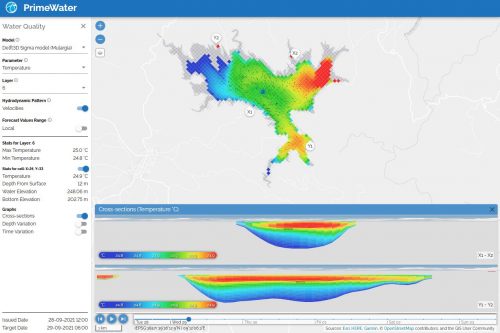Operational Forecasting services for Water Quality in Rivers & Lakes
Having a lead time against hydro-ecological hazards
Why PrimeWater - Benefits
Get Hydro-ecological forecasts just like weather forecasts
State of the art deterministic and ensemble forecasting models transform weather forecasts into hydrological and further downstream into ecological forecasts
Advanced forecasting technologies and models
Benefit from the improved skill of short to medium term forecasts that is achieved with Earth Observations data assimilation techniques
Use the power of ML to restore interactions in highly complex and dynamic systems
Use the power of Machine Learning to develop location specific predictive models allowing for multiple variables and data sources to be used as input.
Applications
Improve preparedness against water hazards such as hydrological extremes and Harmful Algae Bloom events
Identify potential water quality threats such as harmful algae blooms as early as possible and increase the preparedness level of your organization.
Implement proactive, informed decision making and anticipatory actions and reduce the likelihood of a water quality hazard to become a threat.

Product Overview & Key Features
An operational service line powered by hydrological modelling in upstream catchment areas and hydrodynamic & ecological modelling inside reservoirs and lakes, enables the production of short-term forecasts (up to 10 days) of hydrological and water quality related parameters. Hydrological forecasting is performed by the open-source HYPE model, a semi-distributed hydrological model that provides forecasts of river discharges, water temperatures, nutrient and sediment loads in the upstream catchments. Inside the reservoir water a multi-modeling approach combining data-driven models using Machine Learning (ML) algorithms and physics-based 3D hydrodynamic and ecological modelling with Delft3D Suite is performed to estimate water elevations and velocity fields as well as critical water quality parameters for the next 10 days (various algae species, temperature, nitrogen, phosphorus, dissolved oxygen, suspended sediment, etc.).
Key Features
- Forecasts of hydrological parameters for the entire upstream catchment areas of the reservoir.
- Water quality forecasts available for the entire reservoir domain including depth profiles.
- Multi-modelling approach including physics-based and data-driven models.
- Automated data assimilation of Earth Observations including remote sensing and in-situ monitoring datasets for improved forecasting skill.
- Machine Learning error-correcting framework for enhanced forecasting performance.
- Probabilistic Hydrological and Water Quality Forecasting for uncertainty quantification.
- Enable easy integration with external data sources (such as local weather forecasts) or existing calibrated ecological models in the area of interest.
